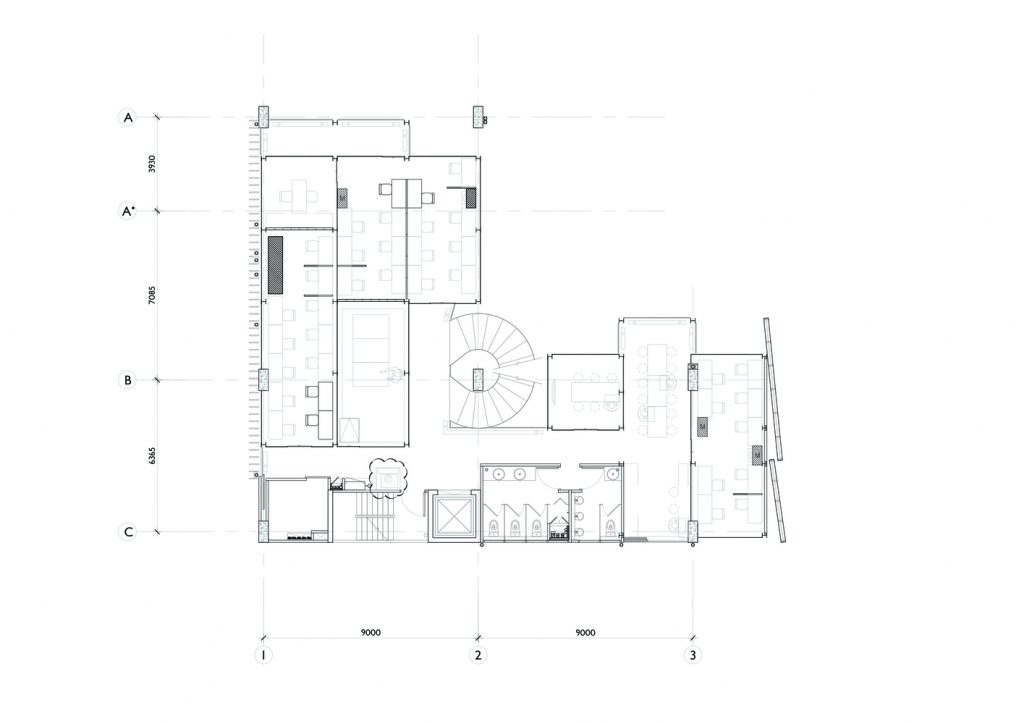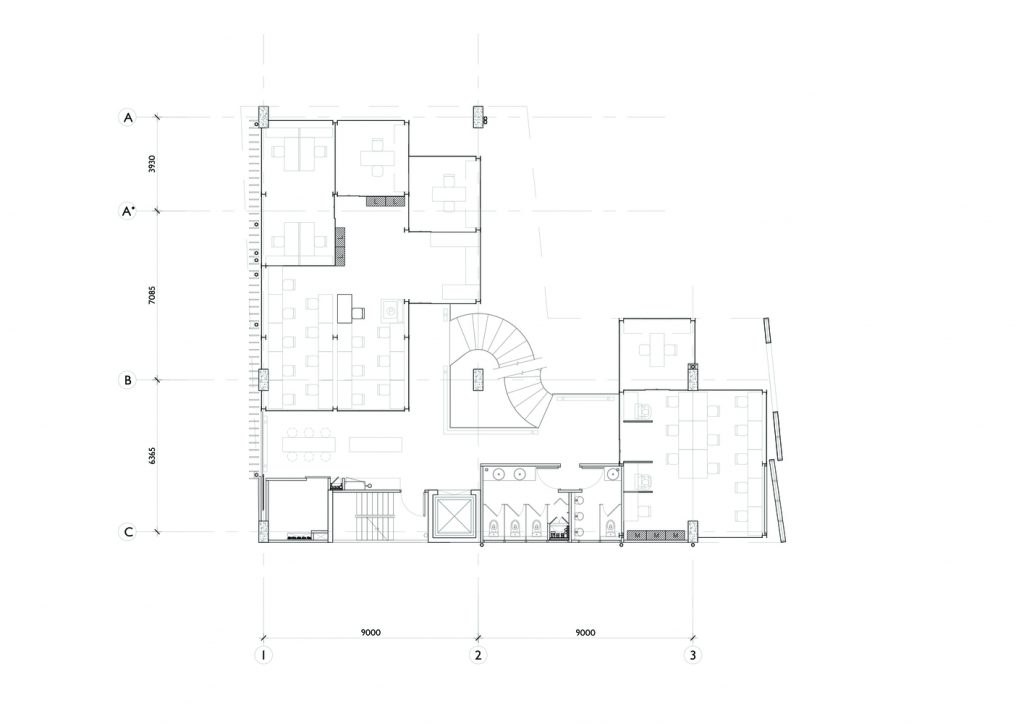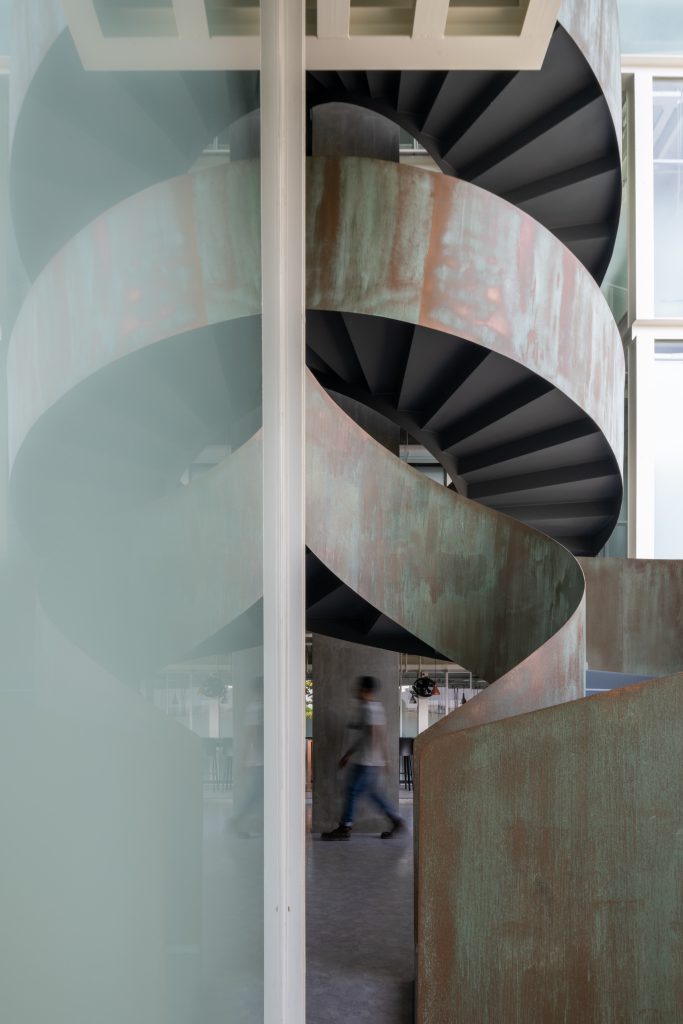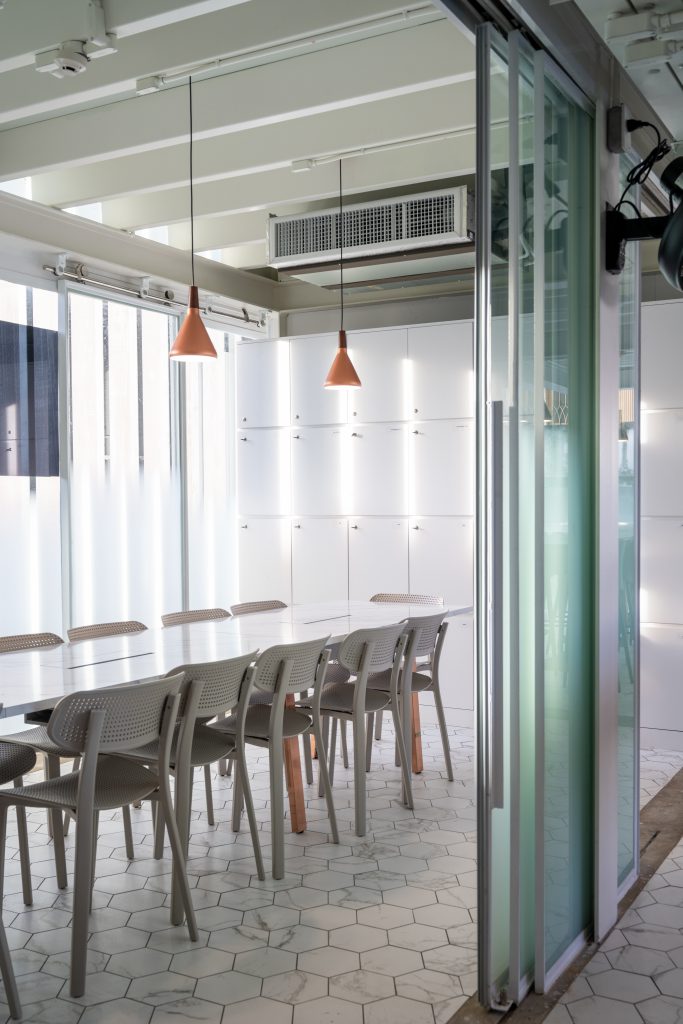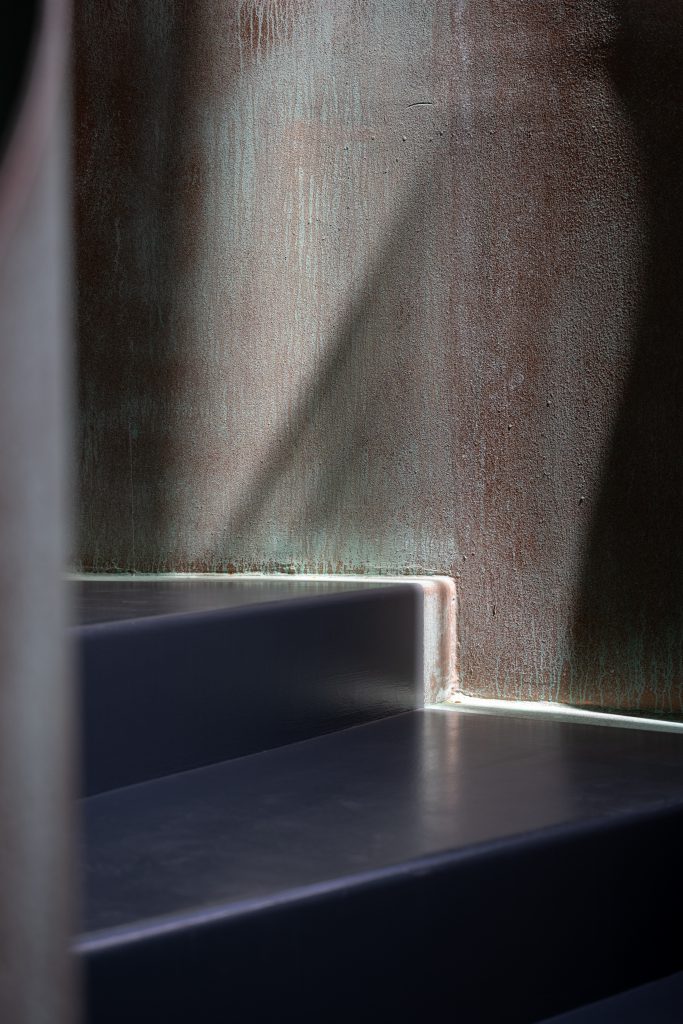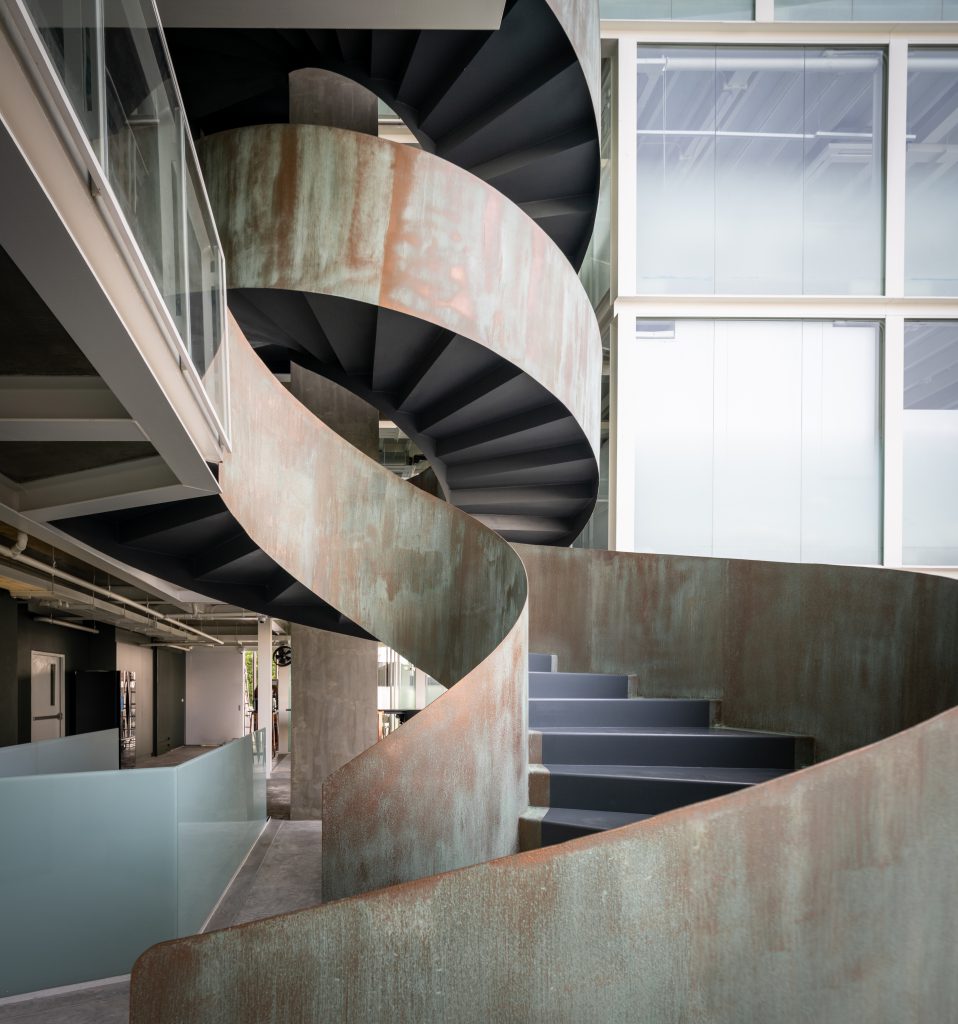In designing the new office for a medical and health products company, TA-CHA Design has curated an en- vironment with a master- ful use of glass to create a workspace that breaks away from the confinement and convention of parti- 1 tioned cubicles.
Text: Rangsima Arunthanavut
Photo: Beer Singnoi, Ta-Cha Design except as noted
Download the online journal Issue 03 Seeing Through Click here
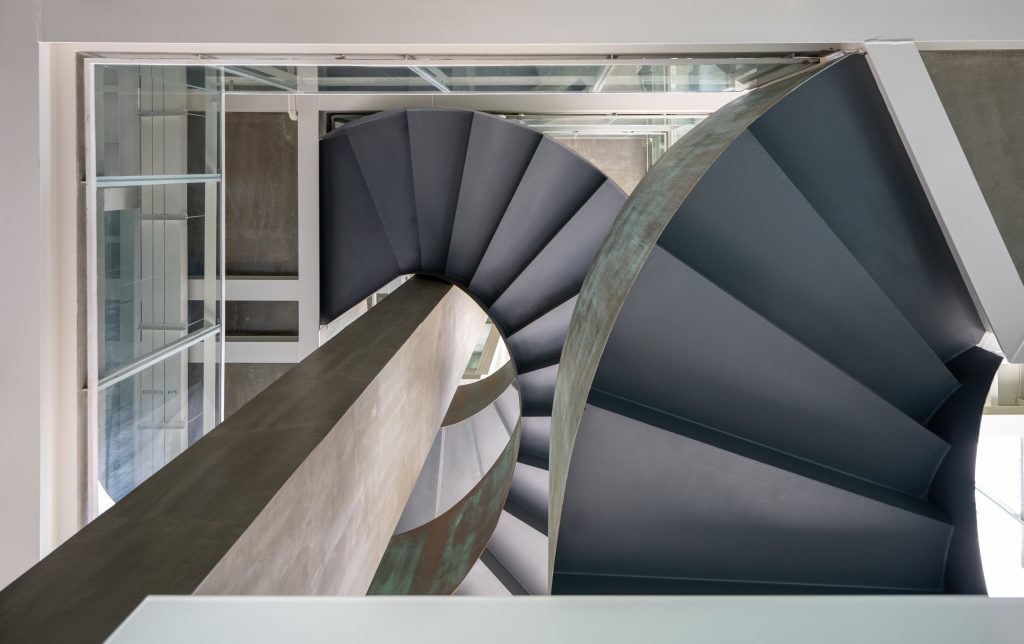
สำนักงานในฝันสำหรับหลายคนคงเป็นภาพของพื้นที่นั่งทำงานที่ยืดหยุ่น มองเห็นท้องฟ้า สัมผัสแสงแดดและลมธรรมชาติ หรือบรรยากาศรอบตัวที่ช่วยบรรเทาความเครียด คำว่า ‘บำบัดทุกข์ บำรุงสุข’ จึงเป็นคำจำกัดความที่ผู้บริหารแห่ง FASHOF บริษัทจำหน่ายยา เวชภัณฑ์ และสินค้าด้านสุขภาพครบวงจร มุ่งหวังส่งต่อสุขภาวะที่ดีทั้งกายและใจให้กับพนักงาน ผ่านการออกแบบอาคารสำนักงานสาขาใหม่บนพื้นที่ดินย่านบางกอกน้อย ที่เติมความเป็นธรรมชาติเข้าสู่ภายในและลดความอุดอู้จากการทำงานตามแบบฉบับสำนักงานยุคใหม่ โดยมีทีมสถาปนิกรุ่นใหม่อย่าง TA-CHA Design ทำหน้าที่ออกแบบให้ตอบรับความต้องการของเจ้าของโครงการ เป้าหมายสำคัญอีกอย่างหนึ่งของทีมผู้บริหาร คือการสร้างความสัมพันธ์ให้เกิดขึ้นภายในองค์กร การสร้างบรรยากาศให้เกิดการปฏิสัมพันธ์กันในแต่ละแผนก หรือการมองเห็นพนักงานทำงานอย่างมีความสุข จึงนำมาสู่รูปลักษณ์อาคารที่โดดเด่นด้วยการใช้กระจกไล่ระดับสีที่โปร่งแสงแต่ไม่โปร่งใส เปิดมุมมองเพื่อสร้างสัมพันธ์ระหว่างกัน ในขณะที่ยังรักษาความเป็นส่วนตัวในการทำงานได้อย่างสมบูรณ์

ทีมสถาปนิกเริ่มต้นงานออกแบบจากการทำความเข้าใจวัฒนธรรมองค์กร และพฤติกรรมการทำงานจากการทำแบบสอบถาม และเข้าไปนั่งสังเกตการณ์เป็นส่วนหนึ่งของการทำงาน จึงพบว่าบริษัทแห่งนี้มีรูปแบบการทำงานที่แตกต่างจากบริษัททั่วไป คือ พนักงานเกินกว่าครึ่งเป็นฝ่ายขายที่นั่งโต๊ะทำงานเพียง 3-4 วันต่อเดือนเท่านั้น ทีมสถาปนิกจึงเริ่มร่างภาพแนวคิดของโครงการ โดยตั้งใจให้มีส่วนหนึ่งของอาคารเป็นพื้นที่เปิดโล่งเพื่อพร้อมตอบรับกิจกรรมที่เปลี่ยนแปลงไปในแต่ละช่วงเวลา การพูดคุยและทำความเข้าใจกับพนักงาน นำมาสู่การจัดวางพื้นที่ใช้สอยให้ตอบโจทย์การใช้ชีวิตในสำนักงาน ประกอบกับข้อจำกัดจากกฏหมายควบคุมอาคารที่ต้องเว้นระยะร่นเพื่อให้รถดับเพลิงสามารถวนรอบอาคารได้ผังอาคารจึงมาลงตัวในลักษณะตัว L สูง 7 ชั้น แบ่งเป็นพื้นที่สำนักงานจำนวน 5 ชั้น ส่วนอีก 2 ชั้นที่เหลือเป็นที่พักอาศัยชั่วคราวสำหรับผู้บริหาร
“จริงๆ เราทำงานไม่เชิงว่ามีแนวคิดตั้งเป็นธงปลายทาง แต่สิ่งที่เราทำคือกระบวนการของงานออกแบบที่จำเป็นต้องทำ อย่างการวิเคราะห์พื้นที่ การทำความเข้าใจผู้ใช้งานอาคารหรือโปรแกรมที่เกิดขึ้น เหล่านี้นำมาซึ่งแนวคิดสำคัญบางอย่างที่เป็นหัวใจของการออกแบบในโครงการนั้นๆ อย่างจุดเด่นของโครงการนี้จะเป็นพื้นที่การใช้งานที่เราพยายามคิดให้ตอบโจทย์พนักงานจริงๆ” สถาปนิก TA-CHA Design ผู้ออกแบบเล่าถึงแนวคิดในการสร้างความสัมพันธ์ระหว่างพื้นที่ภายในและภายนอกเพื่อเติมเต็มบรรยากาศการทำงานให้กับเหล่าพนักงาน โดยจัดให้มีพื้นที่กึ่งเปิดโล่งอยู่บริเวณใจกลางระหว่างปีกอาคารตัว L ทั้งสองด้านและออกแบบให้มีการใช้งานได้อย่างยืดหยุ่น โดยพนักงานสามารถมานั่งรับประทานอาหารกลางวัน ใช้เป็นพื้นที่รับรองแขกในระหว่างวัน หรือช่วงสิ้นเดือนที่ฝ่ายขายต้องเข้ามายังสำนักงานก็สามารถปิดพื้นที่บางส่วนให้กลายเป็นห้องประชุมได้เช่นเดียวกัน โดยการจัดวางผังพื้นที่ในรูปแบบดังกล่าวยังเชิญชวนให้พนักงานเกิดความรู้สึกเป็นอิสระ ได้พูดคุย แลกเปลี่ยนความคิดเห็นกันระหว่างแผนก ที่สำคัญยังช่วยลดความอุดอู้จากการนั่งทำงานในห้องปรับอากาศแคบๆ และช่วยลดการใช้พลังงานจากแสงไฟประดิษฐ์และเครื่องปรับอากาศไปพร้อมกัน
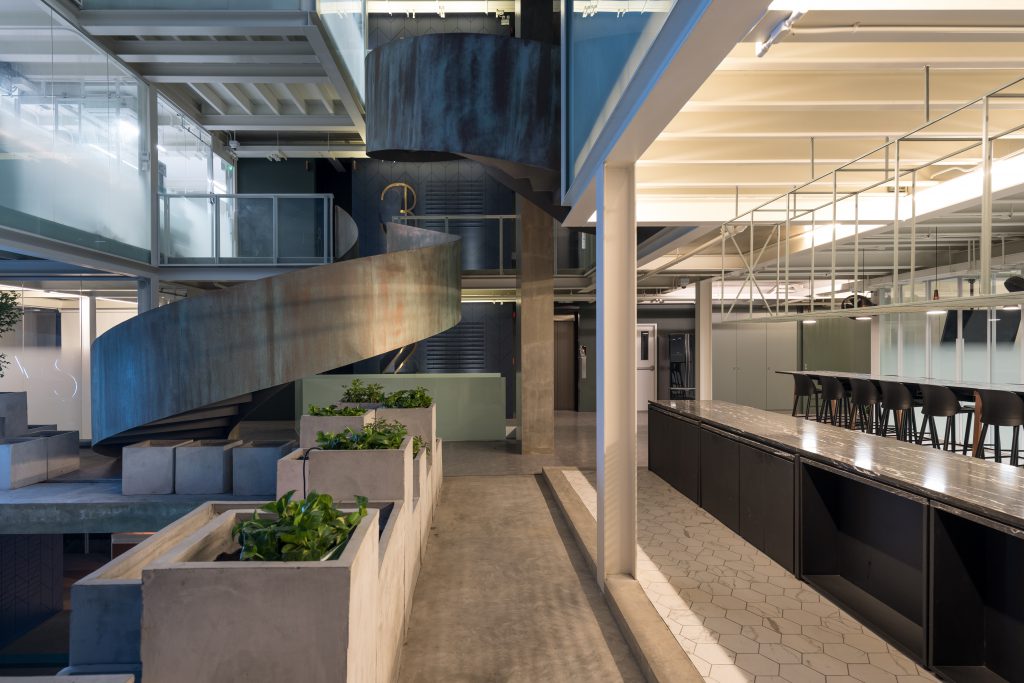
ด้วยผังอาคารรูปตัว L มีการแบ่งพื้นที่ใช้งานปีกซ้ายและปีกขวาเป็นแผนกการทำงานอย่างชัดเจน สถาปนิกจึงออกแบบพื้นที่ในลักษณะของกล่องกระจกที่วางยื่นเข้าออกและลดหลั่นเป็นชั้นไม่เท่ากัน ช่วยสร้างมิติให้กับกรอบอาคาร และที่สำคัญ คือสามารถแยกระบบเครื่องปรับอากาศ ระบบไฟของแต่ละกล่องออกจากกันให้สอดคล้องกับพฤติกรรมการทำงาน โดยพนักงานสามารถบริหารจัดการพื้นที่เองได้อย่างสะดวกและประหยัดพลังงานไปในตัว ซึ่งพื้นที่ทั้งหมดยังเชื่อมโยงถึงกันทางสายตาผ่านการเลือกใช้วัสดุหลักเป็นกระจกโปร่งแสงแต่ไม่โปร่งใสที่ผลิตขึ้นด้วยเทคนิค Ceramic Frit โดยพิมพ์ลวดลายลงบนกระจกก่อนจะนำไปอบด้วยความร้อนเพื่อให้เอฟเฟกต์ของกระจกที่ทั้งขุ่นมัว และโปร่งใสสามารถอยู่ภายในวัสดุเนื้อเดียวกันได้อย่างกลมกลืน
การเลือกใช้วัสดุหลักเป็นกระจกโปร่งแสงที่ไล่เฉดสีความใสจากด้านล่างขึ้นสู่ด้านบน สัมพันธ์กับมุมมองที่เกิดขึ้นทั้งภายในและภายนอก ความขุ่นของกระจกฝ้ายังสร้างคุณสมบัติที่ช่วยบดบังการมองเห็นในบางส่วนเพื่อลดสิ่งรบกวนจากสภาพแวดล้อมภายนอก และช่วยเพิ่มสมาธิให้กับพนักงาน ในทางกลับกันยังบดบังมุมมองจากภายนอกสู่ภายในที่อาจรบกวนสายตาจากสิ่งของจำนวนมากมายในสำนักงานได้อีกทางหนึ่ง “ความโปร่งใสและความโปร่งแสงในงานนี้ จะถูกออกแบบให้ตอบรับกับพื้นที่ใช้สอย หรือการใช้งาน เช่น พื้นที่ที่ต้องการความเป็นส่วนตัว จะเป็นกระจกแบบโปร่งแสงตลอดทั้งแผ่น หรือพื้นที่นั่งทำงาน ที่ต้องการสมาธิในขณะนั่งทำงาน ในขณะเดียวกันสามารถมองสู่ภายนอก ในขณะที่ต้องการผ่อนคลาย พื้นที่ส่วนนี้จะเป็นกระจกแบบไล่ระดับจากทึบแสง 100% ไปหาโปร่งใส ในขณะยืน”
ระยะการเปลี่ยนถ่ายของวัสดุจากกระจกขุ่นเป็นกระจกใส สถาปนิกออกแบบให้สัมพันธ์กับพฤติกรรมการใช้งานและระดับสายตาของพนักงาน ทำให้การทำงานระหว่างวันยังสามารถมองออกไปเห็นสภาพแวดล้อมภายนอก ลดความอุดอู้จากห้องสี่เหลี่ยมทึบๆ ไปได้บ้างไม่มากก็น้อย ส่วนบริเวณชั้นบนสุด ซึ่งไม่ใช่ระดับที่สายตาจะมองเห็น และเป็นที่อยู่อาศัยชั่วคราวของผู้บริหารซึ่งแวะเวียนมาเพียงบางครั้ง ระยะของกระจกไล่เฉดขุ่นและใสจึงเหลือเพียงเล็กน้อยสัมพันธ์ตามประเภทการใช้งาน พื้นที่ปีกซ้ายและปีกขวาที่แบ่งสัดส่วนอย่างชัดเจนยังกลมกลืนเป็นหนึ่งเดียวกันผ่านการออกแบบทางสัญจรหลักอย่างบันไดวน ซึ่งทั้งสถาปนิกและผู้บริหารเห็นตรงกันว่า โครงสร้างบันไดนี้ จะต้องทำหน้าที่เป็นใจกลางของอาคารที่เชื้อเชิญให้พนักงานหันมาขึ้น-ลงบันได เพื่อขยับร่างกายให้มากกว่าที่เคย สู่ผลลัพธ์เส้นสายอิสระของบันไดวนเชื่อมต่อหลายชั้นเข้าด้วยกัน เพื่อที่จะดึงดูดผู้คนให้ใช้งานบันไดแทนการใช้ลิฟท์ และยังเป็นองค์ประกอบหลักที่สร้างความโดดเด่นให้กับอาคารได้อย่างน่าสนใจเมื่อมองจากภายนอก
นอกจากนี้ อาคารแห่งนี้ยังมีการออกแบบที่พึ่งพาธรรมชาติอย่างแสงแดดและลม การจัดวางฟังก์ชันจึงมีการออกแบบจังหวะของช่องเปิดและช่องปิดที่สัมพันธ์กับความเป็นธรรมชาติและทิศทางของแสงแดด เพื่อให้แสงและลมสามารถหมุนเวียนในอาคารได้อย่างเหมาะสมโดยไม่รู้สึกถึงความร้อน การเลือกใช้กระจกนิรภัยเทมเปอร์แบบ Low-E Hard Coated ยังช่วยลดความร้อนที่เข้าสู่ภายในอาคารโดยตรง เนื่องจากบริบทรอบด้านต่างรายล้อมไปด้วยอาคารตึกแถว ซึ่งสถาปนิกมองว่าเป็นสิ่งแวดล้อมหนึ่งที่มีเสน่ห์และบ่งบอกความเป็นย่านนั้นๆ ได้เป็นอย่างดี การออกแบบรูปลักษณ์และการเลือกใช้วัสดุจึงพยายามดึงลักษณะเหล่านั้นเข้ามาผสมผสานให้เกิดความกลมกลืน สู่การใช้โครงสร้างเหล็ก ซึ่งทีม TA-CHA Design ให้ความสนใจอยู่เป็นทุนเดิม เพียงแต่ความพิเศษของโครงการนี้ คือการผสมผสานของโครงสร้างพื้นไร้คาน (Post-Tension Slab) ทำให้สามารถรองรับกล่องกระจกที่วางลดหลั่นชั้นไปมา ทำให้เกิดที่ว่างระหว่างอาคารที่ตอบโจทย์ในเรื่องมุมมอง ความยืดหยุ่น และความสัมพันธ์ของพื้นที่ภายนอก-ภายในได้อย่างลงตัว วัสดุในส่วนอื่นๆ ยังเน้นไปที่เสน่ห์ของสัจจะวัสดุอย่างเหล็ก กระจก เผยความดิบและเฉดสีโทนมืดทึมตัดกับงานตกแต่งภายในซึ่งโดดเด่นในโทนสีสว่าง สร้างบรรยากาศการทำงานภายในที่ปลอดโปร่งสบายตา
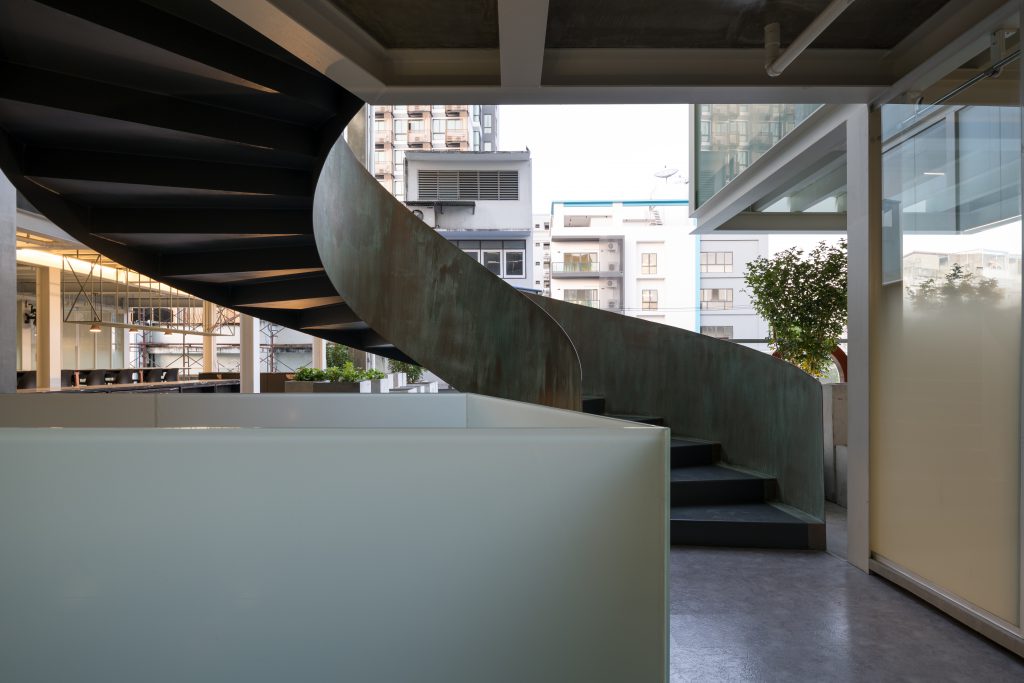
สถาปนิกจาก TA-CHA Design พูดถึงการใช้กระจกในโครงการนี้ว่า “งานกระจกเป็นงานที่มีรายละเอียดเยอะ ราคาสูง และมีข้อมูลทางเทคนิคมาก การปรึกษาผู้เชี่ยวชาญเป็นสิ่งสำคัญมาก ยิ่งงานนี้มีการใช้ระบบ printed ในการทำ ceramic frit การเข้าใจวิธีการทำงานของระบบนี้เป็นสิ่งจำเป็นมากๆ เช่น การที่จะควบระดับตำแหน่งของการไล่โทนของกระจกที่มีความยาวต่างกัน ให้ระดับการไล่โทนอยู่ในตำแหน่งเดียวกันนั้น เป็นขั้นตอนที่ละเอียดอ่อนมาก และมีการผิดพลาดได้ง่าย หากไม่เข้าใจวิธีการทำงาน และการประสานที่ดี ระหว่างผู้รับเหมาหลักกับผู้ผลิต”
จากการทำงานที่ให้ความสำคัญกับรายละเอียดและความร่วมมือกันของทุกฝ่าย ภาพในความคิดระหว่างการออกแบบของสถาปนิก กับภาพของอาคารเมื่อแล้วเสร็จ มีความใกล้เคียงกันมาก และทำหน้าที่รักษาความเป็นส่วนตัว หรือการเปิดมุมมอง ได้น่าพอใจตามที่สถาปนิกต้องการ การสร้างอิสระทางมุมมอง และอิสระทางการเคลื่อนไหวที่เกิดจากการออกแบบวางผังพื้นและองค์ประกอบทางสถาปัตยกรรมของสำนักงาน FASHOF นี้ จึงช่วยส่งผลให้การทำงานผ่อนคลายและพนักงานได้สัมผัสบรรยากาศที่แตกต่างกันในแต่ละพื้นที่ การเปิดและปิดมุมมอง รวมถึงการเว้นที่ว่างของพื้นที่อาคาร และการปิดล้อมให้เกิดความเป็นส่วนตัว หรือความโปร่งโล่งเพื่อการพบปะสังสรรค์ สภาพแวดล้อมต่างๆ ที่เกิดจากการออกแบบโดยการใช้กระจกที่มีรูปแบบต่างๆ กันเหล่านี้เป็นปัจจัยหนึ่งที่ช่วยฉีกกรอบจำกัดจากห้องทำงานสี่เหลี่ยมทึบในแบบเดิมๆ
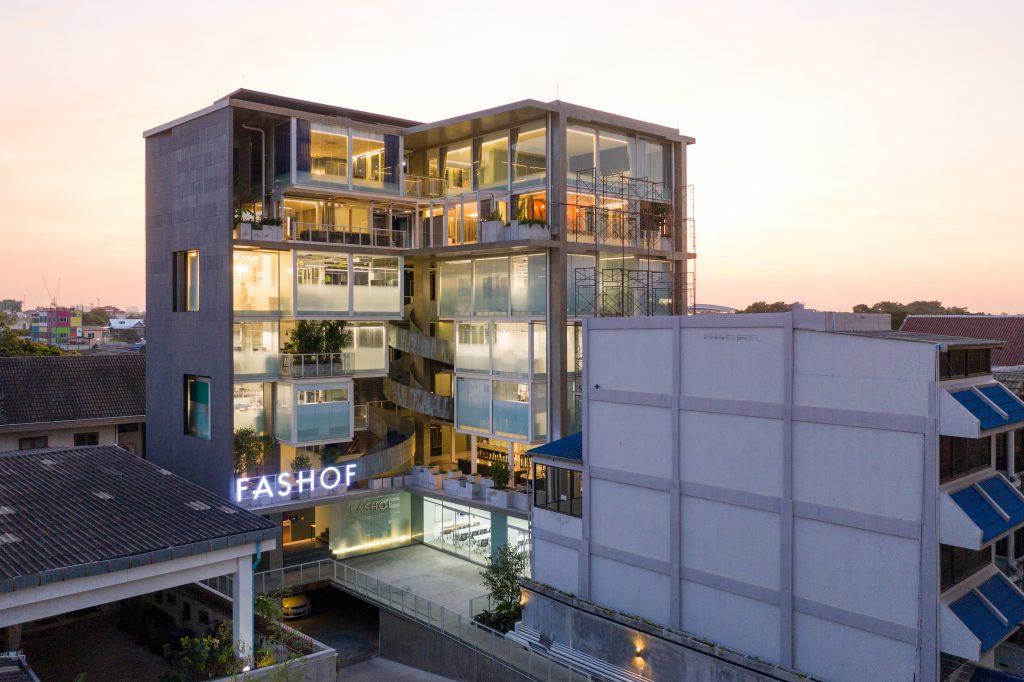
For many, a dream office would involve something along the lines of a flexible, open workspace with the view of the sky as well as the presence of natural light and wind—an overall pleasant and happy surrounding that can help relieve stress from a long day at work. ‘Curing sadness, nurturing happiness’ is what FASHOF, a company selling comprehensive medical and health products, intends to bring to its workplace in hopes of keeping the physical and mental wellbeing of their staff the healthiest possible through the design of the new office building in Bangkok Noi district of Bangkok. The space integrates nature elements into the interior to lessen the discomfort from the confinements of a conventional office space. This new, modern office has the up-and-coming team of architects from TA-CHA Design overseeing the project, materializing the owner’s visions into reality.
One of the important goals of the executive team is to facilitate connections within the organization. The space is designed to encourage interactions between employees from different departments while enabling visibility of the activities going on inside the office. The requirements lead to the formation of the architectural design that stands out for its use of translucent glass to keep the space visually connected and to encourage communication, while still offering a sense of privacy for each employee.
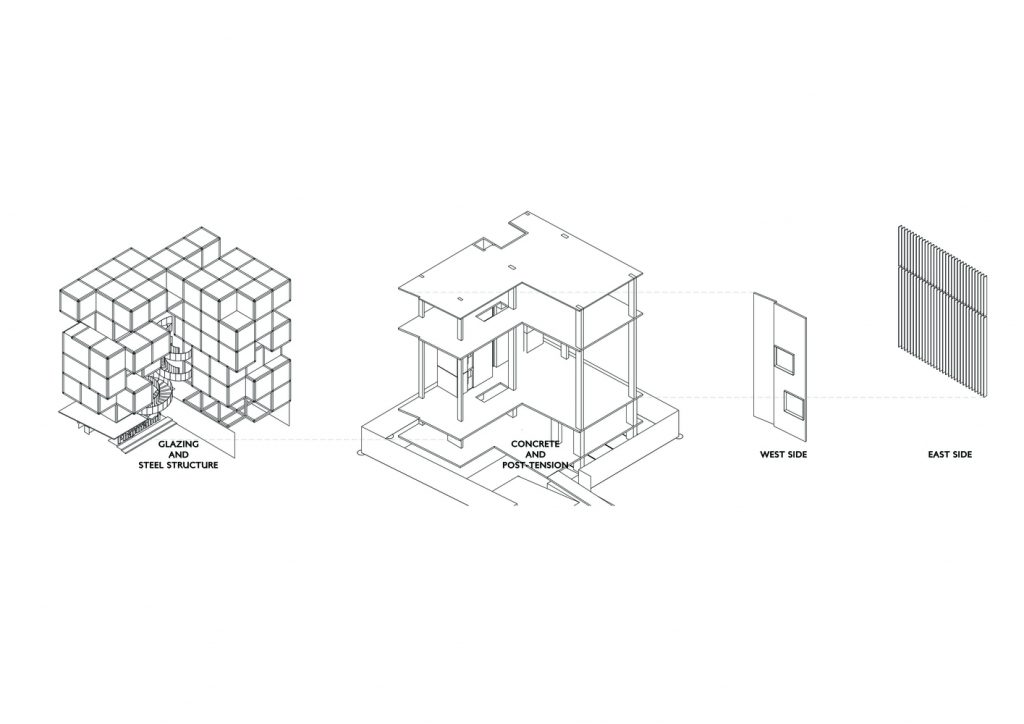
The design bases its development on the company’s organizational culture and employees’ behaviors. The data was obtained through a questionnaire and the architect’s actual observation of the workflow. The process reveals the company’s unique work culture where more than half of the employees are sales representatives who come into the office only 3-4 days a month. This finding led the team to outline the project’s concept with the intention for a part of the spatial program to house an open space that can accommodate different activities at various times of the day. The design team’s conversations with the employees resulted in the allocation of functional spaces designed to cater to the users’ requirements. Following the building laws and regulations, one of the setbacks is that the area must provide enough space for fire apparatus to have access to all portions of the building. The design as a result, is reconciled into a seven-story building with L-shaped layout with office spaces occupying the first five floors and the remaining two stories house temporary accommodation for the company’s executives.
“Actually to be honest, we don’t exactly work with the concept as the end goal, but its a destination that is unveiled through the design process, while figuring out what has to be done. For example, the spatial analysis is carried out based on the understanding of how users are going to use the building and functional program. All these findings lead to the conceptualization of each project. So with this particular office building, it’s about coming up with the functional spaces that really correspond with the needs and behaviors of the employees.
The architecture team of TA-CHA Design talks about the concept behind creating a connection between the interior and exterior spaces, which is realized to make the work environment more functionally and aesthetically fulfilling. The multifunctional semi-open space sits at the center of the two wings stretched out into the L-shaped layout. The space is where employees can sit down and enjoy their lunches or accommodate the company’s guests during working hours. At the end of the month, when the sales representatives come into the office, a portion of the open space can be partitioned into a meeting room. The layout also creates a more relaxing atmosphere for employees to feel a greater sense of freedom to talk and exchange their ideas with fellow colleagues from the different departments. The semi-outdoor space also offers users a break from their small, air-conditioned workspace while simultaneously lessening the use of artificial light and air conditioning systems.
The L-shaped layout divides the functional spaces into a left wing and right wing, each housing different departments. The architect designs several sections of the functional program into a series of glass boxes, which protrude and ascend from the building’s structure in a sequence, bringing an interesting dynamic to the architecture. More importantly, the separated sections also enable the air conditioning and electrical system to operate independently and more specifically to the employees’ use of space, allowing each individual to manage their own workspace while lessening energy consumption. The entire space is connected visually through the use of translucent glass. Manufactured using the Ceramic Frit technique, the designed pattern is imprinted on the glass before it goes through the firing process that renders a glass panel where translucent and transparent textures beautifully merge.
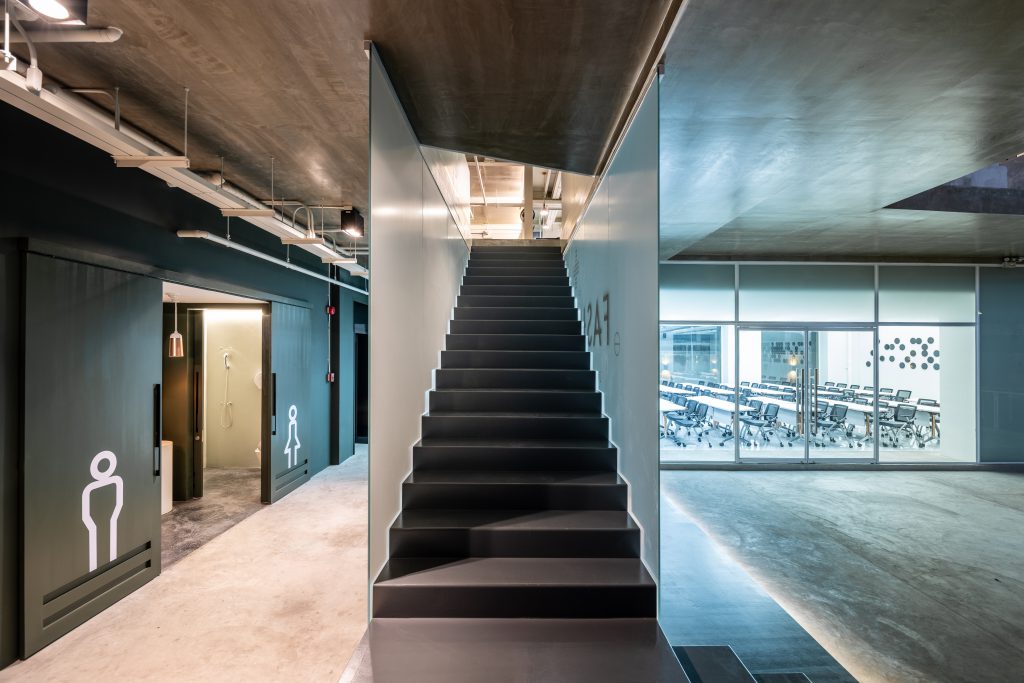
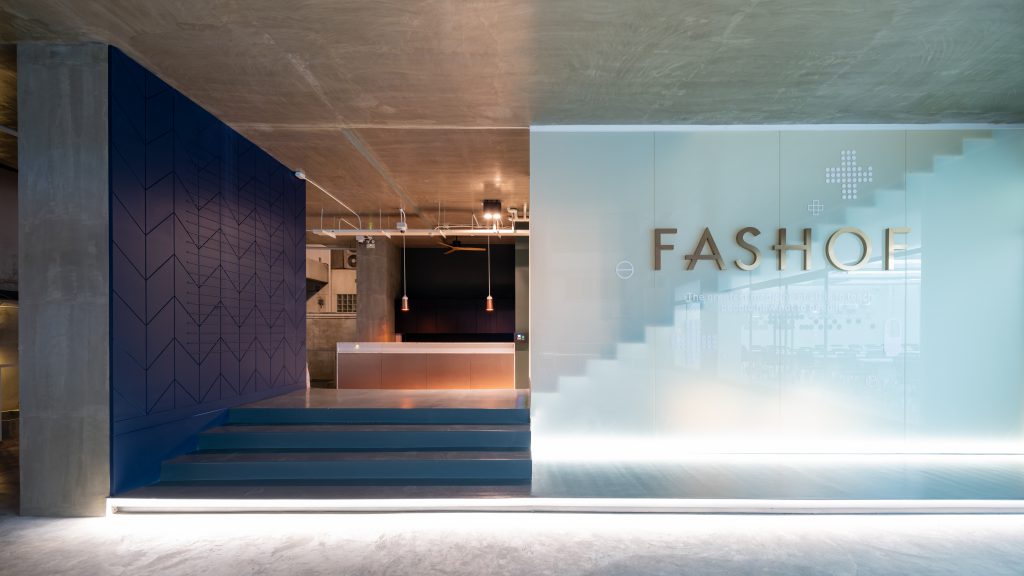
The gradually changing transparency of each glass panel has the most opaque texture covering the lower section, corresponding with the architecture’s interior and exterior perspectives. The translucent attributes also conceal the visibility of the interior functional space, preventing the outside environment from disturbing the employees. Meanwhile, it shields the unpleasant sight of an unorganized office space from disturbing the building’s outside appearance. “Transparency and translucency are designed to coincide with different parts of the functional program and how users use each space. For instance, we use translucent glass in the space where privacy is needed, as well the area where employees want to be extra focused while they’re working. Meanwhile, they are given access to the outside environment in case they want to take a break from work and we use the glass where the lower part is 100% opaque and when one stands up, they can look through the transparent section and enjoy the outside view.”
The range where the glass’ surface transitions from being translucent to transparent relates to users’ behaviors and average eye levels, meaning they can take a break from being inside their confined workspace and look outside to the surrounding environment. The highest floors are where the executives’ temporary accommodation is located. Since the space is only being used occasionally, the transitioning range between the translucent and transparent surface is reduced, coinciding with how the space is used.
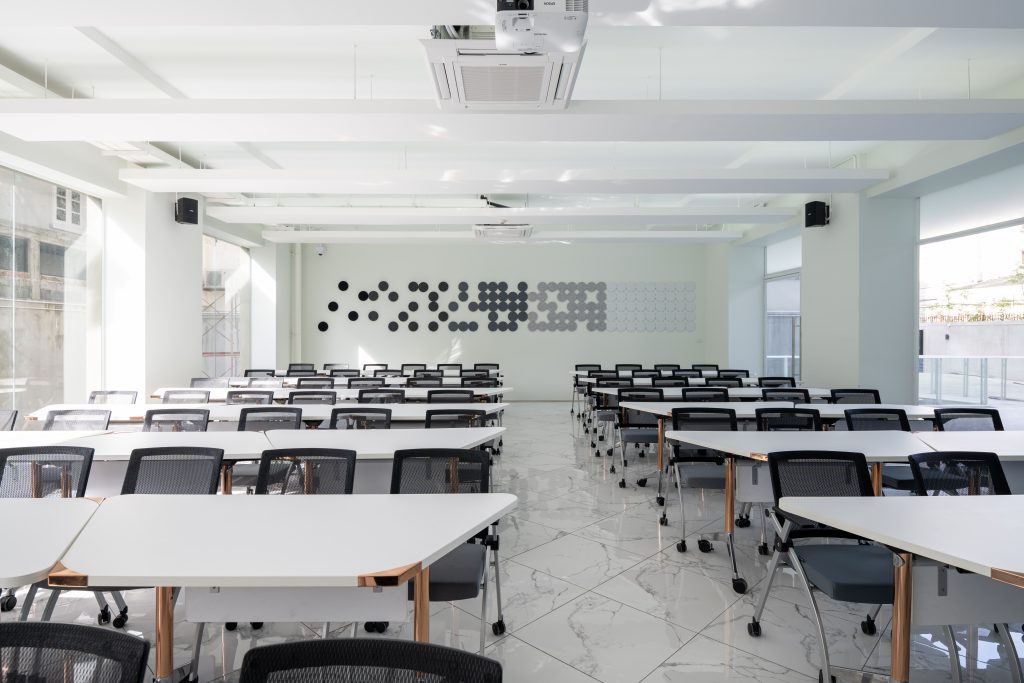
The well-proportioned left and right wing are divided yet unified into one connected program thanks to the design of the spiral staircase, which serves as the main circulation. Both the design team and the company’s executives agree that the stairs will serve as the heart of the building and encourage employees to walk and move their bodies more. The intention is translated into the curved lines of spiral staircases that connect various floors of the building together with the design that hopes to appeal to users to walk instead of using elevators. The visually striking stairway also becomes a distinctive architectural element for the building when viewed from the outside.
Additionally, the building is designed to incorporate and rely on the presence of natural light and wind with the functional program that houses a series of openings and enclosures that are derived from natural airflow and sun direction. The approach allows these natural elements to circulate the functional space without bringing in any unwanted heat. The use of Low-E Hard Coated tempered glass also helps reduce the heat from directly intruding the building’s interiors.

Seeing as how the project’s surrounding context is a highly populated residential area with rows of shophouses as neighbors, the architect embraces the neighborhood’s charm by materializing the design and using materials that bear a connection to the characteristics of the area. For instance, the design team uses a steel structure, which is one of TA-CHA Design’s main interests, by combining it to the use of post-tension slabs to make the weight bearing of the protruding glass boxes possible. This results in the birth of negative spaces, which grants interesting perspectives, flexibility and a relationship between interior and exterior spaces. The design reveals the natural attributes of materials such as glass and metal, showcasing their raw details and colors, which nicely contrast with the bright tone of the interior decoration, curating a workspace that is not only physically spacious but visually comfortable and pleasing.
“Glass comes with a lot of details, technicalities and a higher cost. It requires a lot of technical knowledge and consultation with experts is extremely crucial. For instance, to be able to control the position of glass panels with different lengths and surfaces while keeping the transitioning ranges relatively close requires a great attention to detail. Things can go wrong easily during the process if there’s a lack of understanding and collaboration between the main contractor and manufacturer,” the architecture team of TA-CHA Design explains the challenges from the use of glass in this project.
With mutual understanding in details and teamwork of all parties involved, the vision gets materialized into an almost perfect reality. The design provides both the privacy and the openness and spaciousness of the functional program, just like the architecture and owner intended, rendering the freedom to the way spaces are perceived and interacted. The design of the layout and architectural elements of this office building has brought a more pleasant and relaxing work environment and experience to everyone. Each part of the program offers a different atmosphere while openness and enclosures exist in ways that relate to how the spaces are used, whether for casual gatherings or serious meetings. The design team curates an environment with a masterful use of glass to create a workspace that breaks away from the confinement and convention of partitioned cubicles.


